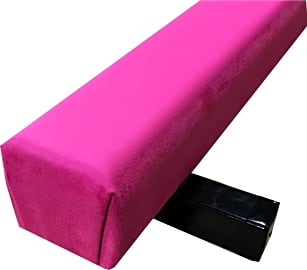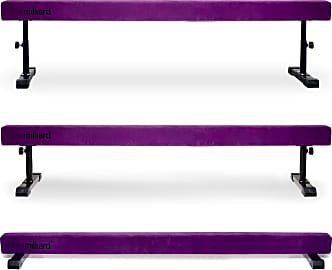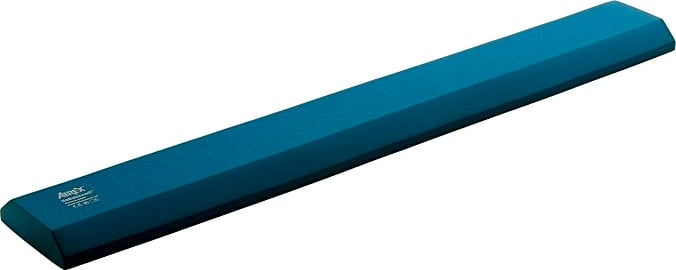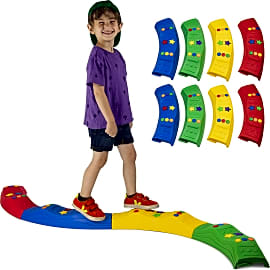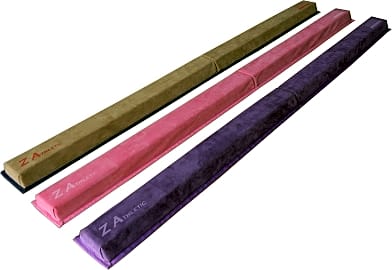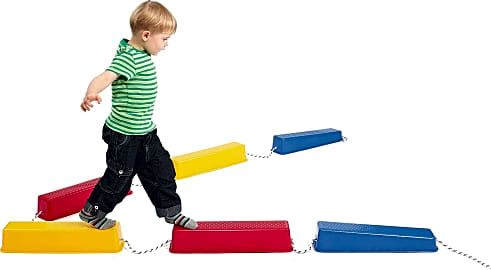The 10 Best Balance Beams

This wiki has been updated 38 times since it was first published in July of 2015. Whether you have a budding gymnast in the family or are looking for a new way to help your preschooler develop mobility and coordination, one of these balance beams will be perfect for your needs. We've included models that sit on the floor as well as raised options, along with some folding units that are easy to store, so there should be at least one to suit every skill level and home. When users buy our independently chosen editorial recommendations, we may earn commissions to help fund the Wiki.
Editor's Notes
May 14, 2021:
One of our selections meant for young kids was no longer available, so we've replaced it with another meant for youngsters. The amusingly named Little Chubby One is designed to train clumsy kids (which is most of them, really) to walk upright and balanced on uneven terrain. We also updated to the latest version of the Airex Balance Pad, which is another one not meant for gymnastics use. Instead, it's intended for physical therapy, where stretches and balance exercises can make all the difference in a patient's recovery. We still recommend the Tumbl Trak Brianna for premium gym practice, and the Milliard High and Low as a lower priced alternative.
February 14, 2020:
Identifying the right balance beam depends greatly on the user's skill level. For example, if a person is just getting started with their beam training, a low-profile model like the Z-Athletic ZATH-TLB, which is just two inches tall, is a smart option. The Spri Airex and We Sell Mats Foam Bar are also good choices, as they are 2.5 inches or less in height. On the other hand, experienced gymnasts will want something with a bit more height, such as the Milliard High and Low, which is an adjustable model that can stand as high as 24 inches tall, or as low as seven.
Build materials should also factor into one's buying decision. Beams with a solid wood core, like the Tumbl Trak Brianna, The Beam Store PK8001, and Milliard High and Low can support the heaviest users and will have the least amount of flex. However, these will also be the most difficult to move, and generally the most time consuming to set up and hardest to store. If you want something that offers a bit more convenience, you will have to consider a foam unit, like the We Sell Mats Foam Bar and Z-Athletic ZATH-TLB, both of which fold in half and weigh just a few pounds.
For kids, we highly recommend the Everlast WeeKidz Set or Edx Education Step-a-Logs. The former can help teach or reinforce shapes, numbers, and letters, while the latter has tapered edges for easy entry and exit. It can also be used outdoors in a playground right alongside a swing set and teeter totter, thanks to its hard plastic constructions.
Special Honors
WillyGoat Curved Balance Beam Challenge While it may not be what professional gymnasts use in competitions, the Curved Balance Beam Challenge can be significantly more fun for the average child who doesn't have dreams of being the next Shannon Miller. Plus, its heavy-duty construction can accommodate multiple kids at once. willygoat.com
AK Athletic Equipment Play and Learn Ideal for young children and beginners, the low-profile beam of the Play and Learn sits atop a 1 3/8-inch thick floor pad that minimizes the chances of injury from a fall. It is available in three sizes and multiple color combinations. akathletics.com
Choosing A Balance Beam For Every Level
These run about 12 feet long and offer plenty of room to pull off back handsprings, standing back tucks, and other tricks that will impress in competitions.
Whether your child has just asked to start taking gymnastics lessons, has been in the sport for a while, or is already appearing in regional competitions, there are specific balance beams suited for each level. Beginner gymnasts will mostly focus on strength and flexibility. They won't even consider performance-style tricks, like those done on vaults or uneven bars, until much later. At this stage, it's simply important that they become comfortable with their beam. So, for beginners, you want a balance beam that is low to the ground. Around two inches high is ideal because it familiarizes your child with the feel of a balance beam, without distracting her with the fear of falling. Beginners' beams should also have a wide top surface (around four inches wide), giving your little gymnast plenty of room to move around without falling off. They should have an even wider base (around six inches wide) to provide stability. Beginners' beams should be made out of a thick foam, to provide your child's joints with plenty of support.
When your kid is ready to move to intermediate exercises, like back walkovers, cartwheels, and tumbling, you can upgrade her to a beam with a wood core and suede covering. This will get her more comfortable with the stiff feel of performance beams. Intermediate beams will sit slightly higher off the ground than beginner ones, at around four inches tall. These will also be longer than beginners' beams, at around 10 feet in length, to allow for more advanced exercises. Intermediate beams, unlike beginner ones, won't sit flush against the ground, but rather will stand on short supports.
If your child is already competing in front of judges, she's ready for an advanced beam. These run about 12 feet long and offer plenty of room to pull off back handsprings, standing back tucks, and other tricks that will impress in competitions. Advanced beams will have a steel core because they need to be able to withstand the pressure gymnasts might apply to them when they land after advanced tricks. Advanced beams do, however, have a padded top to prevent gymnasts from hurting themselves when they land. These beams will stand on elevated supports and may rise as far as 12 inches off the ground.
The History Of The Balance Beam
Balance beams have evolved significantly since their creation. Over 250 years ago, German physical education teacher Johann Christoph GutsMuths made one of the first beams. It was simply a rounded pine tree trunk that ran about 64 feet in length. GutsMuths wrote an entire chapter about this beam in his book Gymnastics for Youth, which circulated through P.E. programs at the time, offering fun exercises for children.
Friedrich Ludwig Jahn, also known as "The Father of Gymnastics" improved upon the beam around 1816 by adding supports, elevating it like the advanced models seen today. People didn't start using beams in competitions until 1921, in Leipzig, Germany. The beam remained very long (likely between 40 and 60 feet long) until the 1950s, when it was finally reduced. In 1966, Erika Zuchold became the first woman to perform a back handspring on a balance beam at the World Championships. In 1968, gymnast Věra Čáslavská made history as one of the first women to perform a front handspring on the tool.
Zuchold's and Čáslavská's popular tricks inspired a few adjustments to the beam. Handsprings put a lot of pressure on the beam, and so models with two additional legs in the middle started to show up. Slowly but surely, gymnasts started creating and performing more flipping exercises that necessitated a few more improvements we still see today, like a suede covering and padding.
The Health Benefits Of Gymnastics
There is a reason plenty of people aspire to have a gymnast's body. This type of exercise doesn't only make one look good, but it also enhances a lot of other important features of a person's wellbeing. Doing gymnastics regularly can improve your flexibility. It lengthens and stretches your muscles, which allows them to achieve a greater range of motion over time, using less energy. This can greatly reduce your chances of injury. Doing gymnastics on a regular basis can prevent injury in another way, too: through better coordination. Gymnasts tend to have less of a startle response to sudden changes in stimuli, which helps them react to sudden movement with more caution.
Gymnastics requires a certain level of problem-solving in order to pull off tricks safely.
Weight-bearing activities, such as gymnastics, can improve bone strength, too. In fact, one study found that weight-bearing activities can reduce the production of a harmful protein in men's bones and promote a bone growth hormone. Those who aren't comfortable with lifting weights might enjoy the fact that all they need to use is their body and a beam to get the weight-bearing benefits of gymnastics.
Gymnastics also help children develop cognitive skills. Gymnastics requires a certain level of problem-solving in order to pull off tricks safely. Gymnasts have to make very precise calculations to ensure a trick will go as planned. This can sharpen their brains in other areas of life, too. Gymnastics can even encourage a healthy diet. Since gymnasts perform mostly body weight exercises, keeping a healthy BMI is an important part of being able to execute certain skills.



